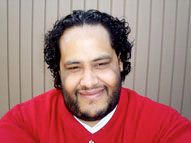I've been racking my brain looking for the silver lining in all of this. I started this blog as a positive force and with all that's been going on with my health I sort of lost that along the way. Here's what I think...My whole goal was to lose weight and improve my overall health. I guess that getting to the bottom of why I've been experiencing this serious fatigue all these years is just a part of that quest. Of course I'm tired all the time and I can't focus on my daily routine and I know that my lack of sleep is not helping my weight loss but if this is what it's going to take for me to sit my doctors down and make them take me seriously then so be it. Then we can finally get to the bottom of it all and I get the proper treatment for each of my conditions instead of lumping everything under obesity and diabetes and hoping that they all just work out.
I saw my Internist again today and he seemed to finally listen to all my symptoms. He changed my sleeping medication and he referred me back to my behavioral medicine specialist to discuss a referral to a psychiatrist who is the most qualified to diagnose and treat Sleeping disorders. He even finally mentioned that he was not to up to date on the treatment of sleeping disorders (which to me explains why he seemed to never really acknowledge it when I mentioned my sleep attacks before). I think he hears me now.
So there's my silver lining and I plan to keep plugging along. I just have a few more factors to add to the drama of it all. Looks like it's gonna be more exciting than I had planned. yay for me... ;0)
And for those of you not familliar with NARCOLEPSY I coppied some facts for you. When I read it it was almost like some one took it all right out of my head. Now keep in mind I haven't been diagnosed by any means but I experience all of these symptoms and have for a couple of years now. I always thought it was caused by my weight and thought that I was just fat and lazy. Anyway...here you go...fun stuff huh?
http://www.narcolepsynetwork.org/faq.php1. QUESTION: What is narcolepsy?
ANSWER: Narcolepsy is a sleep disorder of neurological origin, characterized by excessive daytime sleepiness. It can begin at any age and continues throughout life. It frequently becomes noticeable during the teens or early twenties but it can also appear later in life. Predisposition to it seems to be hereditary. It is believed to affect approximately 1:1,000 people of both sexes and all races. It is not degenerative; people with narcolepsy can expect to live a normal life span.
2. QUESTION: What are the symptoms? ANSWER: There are four primary symptoms:
[1] Excessive Daytime Sleepiness (EDS) includes daytime sleep attacks, which may occur with or without warning (and for many are irresistible); persistent drowsiness, which may continue for prolonged periods of time; and "microsleeps", or fleeting moments of sleep intruding into the waking state.
[2] Cataplexy (the other hallmark symptom of narcolepsy) is a sudden loss of voluntary muscle control, usually triggered by emotions such as laughter, surprise, fear or anger. It occurs more frequently during times of stress or fatigue. The cataplectic attack may involve only a slight feeling of weakness and limp muscles (such as sagging facial muscles, a nodding head, buckling knees, loss of arm strength, 'garbled’ speech); but it may also result in immediate total body collapse, during which the person may appear unconscious, but remains awake and alert. These attacks may last from a few seconds up to thirty minutes.
The two other symptoms are [3] hypnagogic hallucinations - vivid, realistic, often frightening dreams; and [4] sleep paralysis, or a temporary inability to move. Either one of these can occur during the process of going to sleep or waking up, while the brain is partially asleep and partially awake.
3. QUESTION: Are there other symptoms?
ANSWER: The following secondary or auxiliary symptoms may appear:
[1] Automatic behavior, the performance of a routine task, without conscious awareness of doing it, and often without later memory of it;
[2] Disrupted nighttime sleep, involving multiple arousals.
Other difficulties may be caused by the primary symptoms, appear as side effects of medication, or result from one's continuing struggle to cope. Feelings of intense fatigue and continual lack of energy are often reported, and depression is also common. The ability to concentrate and memorize may become more difficult. Vision (focusing) problems, eating 'binges', weak limbs, and difficulties in handling alcohol may also occur.
4. QUESTION: How are these symptoms all related to narcolepsy?
ANSWER: Narcolepsy is related to REM (rapid eye movement) sleep, the dreaming portion of sleep. As a protection against acting out dreams, the muscles become immobile or "paralyzed”. For the normal person, a sleep period first progresses for about 90 minutes of non-REM sleep and then REM sleep begins. But for a person with narcolepsy, sleep begins almost immediately with REM sleep. Since the brain may not be totally asleep when dreaming begins, the dream is sometimes experienced far more vividly and is thought of as a hallucination. After waking, REM periods, or fragments of REM, occur inappropriately throughout the day. This explains excessive daytime sleepiness. Cataplexy is related to the muscle "paralysis" of REM. When automatic behavior occurs, sleep has partially overtaken the brain, but the body continues to perform familiar tasks.
5. QUESTION: Is narcolepsy a psychological or mental disorder?
ANSWER: Narcolepsy is a neurological disorder. Medical researchers have recently identified the cause as the absence of a neurotransmitter, normally present in the hypothalamus region of the brain, which produces the hypocretin peptide essential to the human sleep-wake cycle. Nevertheless, psychological problems can develop from misunderstanding of and difficulty in coping with the symptoms. A very difficult fact to understand for one with narcolepsy and those around him or her, is that sleepiness and sleep attacks are uncontrollable. Failure to accept this may seriously influence self-esteem or personal relationships. Health care counseling for persons and families with narcolepsy can help alleviate these secondary problems. Educating the public, especially school, health, and human resource personnel can help lessen or prevent many other problems.
6. QUESTION: Does narcolepsy affect learning?
ANSWER: Although narcolepsy does not directly affect one's intelligence, learning and education cannot help but be affected by the symptoms. Study, concentration, memory, and attention span may be periodically impaired by sleep. Children with narcolepsy should be identified at the earliest possible age to avoid lowered self-esteem and a pattern of failure adjustments in learning habits may be continually necessary. This can be accomplished with the cooperation of school personnel.
7. QUESTION: Is cataplexy dangerous?
ANSWER: Mild cataplexy, while perhaps embarrassing, is not dangerous. One can often find support for weakened head, neck, or arm muscles, so that others may not even be aware of the momentary loss of control. However, severe cataplexy, resulting in immediate and sudden body collapse, can be dangerous. Companions should be told in advance what to expect and how to help. They should always check for the person's safety and comfort immediately relieving any unnatural bending of limbs or unusual body positions, assuring complete relaxation, and then allowing him or her to recover spontaneously. Cataplexy for others can be so instantaneous that there is no time to prepare for safety and serious injury can occur. Some deaths and near-deaths have been reported. Obviously, potentially life-threatening situations should be avoided unless cataplexy is controlled.
8. QUESTION: How is a diagnosis of narcolepsy determined?
ANSWER: Excessive daytime sleepiness (EDS) is often the first symptom to appear, and for some, the ONLY symptom of narcolepsy. However, it is also a symptom of various other medical conditions. Cataplexy, on the other hand, is almost unique to narcolepsy. The combination of EDS and cataplexy allow clinical diagnosis of narcolepsy, but the presence of cataplexy is not required for a diagnosis of narcolepsy.
In most cases, laboratory tests are still needed to confirm diagnosis and determine a treatment plan. The usual procedure includes an overnight polysomnogram (PSG) at a sleep disorders center to determine the presence of EDS and perhaps other underlying causes of this symptom. This is followed by the Multiple Sleep Latency Test (MSLT) which measures sleep onset and how quickly REM sleep occurs. The MSLT is the most widely accepted diagnostic test for narcolepsy.
Finally, a genetic blood test has been developed which measures certain antigens often found in people who have a predisposition to narcolepsy. Positive results suggest but do not prove narcolepsy. This test is sometimes used when the diagnosis is in question.
9. QUESTION: How is narcolepsy treated?
ANSWER: The goal is to increase daytime alertness and to lessen recurring cataplexy, using minimal medication. Excessive Daytime Sleepiness (EDS) and cataplexy are treated separately. Traditionally, central nervous system stimulants (e.g. Ritalin, Dexedrine) have been used for EDS. In 1999, Provigil (modafinil) was approved as the first non-amphetamine wake-promoting drug for EDS. Tricyclic antidepressants and serotonin reuptake inhibitors (e.g. Vivactil, Tofranil) have been used for cataplexy and REM symptoms. A new drug, Xyrem (gammahydroxybutyrate) is being studied in FDA clinical trials.* Preliminary results suggest it is both safe and effective for these symptoms.
In addition to drug therapy, 2 or 3 short naps during the day help to control sleepiness and maintain alertness. Proper diet and regular exercise also help. And some report benefits from alternative remedies, such as herbs, phosphates, and acupuncture.
Continuing doctor-patient communication is necessary. Equally important is educating one’s family, friends, teachers, and co-workers about narcolepsy. Joining a support group is recommended.















